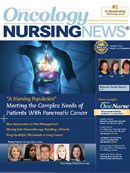My Worst Nightmare: A Spelling Bee With Only Oncology Drug Names
An oncologist told me he retired because he couldn't pronounce the names of the drugs anymore.
Lisa Schulmeister, RN, MN, APRN-BC, OCN®, FAAN
Editor-in-Chief OncLive Nursing
Oncology Nursing Consultant, Adjunct Assistant Professor of Nursing Louisiana State Health Sciences Center in New Orleans, Louisiana
An oncologist told me he retired because he couldn’t pronounce the names of the drugs anymore. Neither can most of us when a new drug or biologic agent is introduced, and we see the odd spelling of the drug name for the first time. Ever wonder where generic and trade drug names come from?
There is actually a method to the madness. Generic drug names usually describe a drug’s physiological function or its chemical structure. The generic drug naming process was formalized in 1961 when the American Medical Association, the US Pharmacopeial Convention, and the American Pharmacists Association created the US Adopted Names (USAN) Council to select concise generic names. The FDA joined the council in 1967.
The USAN Council names the active ingredients in drugs, biologics, vaccines, and even contact lenses and sunscreens. The council then recommends generic names to the World Health Organization’s International Nonproprietary Names program, which ultimately chooses a single generic name for each new drug that is acceptable worldwide and then used globally. Drug manufacturers are required to obtain generic drug names using this process in order to bring new drugs to market.
Generic names for drugs are constructed with affixes and stems that classify the drugs into different categories and sometimes are used to distinguish drugs within categories. For example, the suffix “mab” indicates the drug is a monoclonal antibody, “ximab” indicates it’s a chimeric antibody that responds to more than one antigen, and “zumab” refers to humanized antibodies.
Drug manufacturers can suggest generic drug names to the USAN Council; however, any name that suggests the drug is superior to or more effective than another drug will not get approved. On occasion, the council approves manufacturer’s requests for proposed generic drug names. For example, Onyx Pharmaceuticals’ multiple myeloma treatment carfilzomib is named after molecular biologist Philip Whitcome (who was a founder of the company that first developed carfilzomib) and his wife, Carla, who both succumbed to cancer (the “Ph” in Philip was changed to an “f” to make the name compatible with multiple languages). Dasatinib for CML is named for research fellow Jagabandhu Das. In keeping with USAN Council requirements, both of these generic drug names include a suffix that describes the classification of the drug (eg, carfilzomib is a proteasome inhibitor and dasatinib is a tyrosine kinase inhibitor).
Choosing a brand, or trade, name is an entirely separate process, and an interesting one. Historically, trade names incorporated or resembled their chemical or generic names. For instance, the chemical name of Tylenol is N-acetyl-p-aminophenol so it’s easy to see where the trade name originated. Over time, though, trade names have become largely independent of their generic or chemical names.
The process of developing a trade name for a new drug is complex. The manufacturer’s goal for a new name is that it is distinctive and memorable, while at the same time is not a drug name that looks or sounds like the generic or trade name of a drug already on the market. In addition, the trade name ideally is easily pronounceable; however, with the proliferation of new drugs of all types, this isn’t always possible.
Manufacturers often use creative agencies to come up with new trade drug names, and then use third-party organizations (such as the Brand Institute) to obtain feedback about the proposed trade names. The proposed names are reviewed for similarity to existing drug names, implied unsubstantiated or false claims (for instance, does the drug name imply cure?), and possible name confusion (years ago, a proposed drug trade name was eliminated because it sounded like “the name of one of Santa’s reindeer” to a number of people surveyed).
Once the trade name has been finalized, it’s up to the manufacturer to market the drug and educate clinicians and consumers on how the drug’s trade name is pronounced. Trade names starting with the letter “X” have been especially challenging to pronounce when they’re seen for the first time. Likewise, there are several trade names of oncology agents that are pronounced differently than they look phonetically, which reminds us all of our elementary school days when we were learning how to read.




